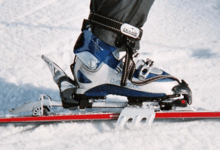Touring binding
A touring binding is a ski binding for touring skis .
The decisive feature of a touring binding is that the ski boot is only fixed at the tip of the boot when stepping on, while the heel can move freely vertically. The heel is also fixed for skiing, and the touring binding corresponds to its function as a normal ski binding.
Nowadays a touring binding has an adjustable climbing aid, lanyard or ski stopper and a device for attaching crampons .
Development history
The ski bindings with cable tensioners and side fixation with front jaws that were common in the past until the 1960s were automatically touring bindings as well. You only had to detach the cable from a deep-drawn hook on the side.
The Hausleithner binding, developed in 1965 for military skiing by Andreas Hausleithner - technical employee at the mountain and winter combat school - manufactured by Heinrich Wunder KG in Dachau, was the first touring binding that had the 90-degree angle for comfortable walking and thanks to their wire hanger jaws, they made it possible to use almost any more stable mountain boot. After a successful test on the Haute Route in May 1966, it was given its civil name Silvretta Saas-Fee. A further development with a riveted plate made it much easier to guide the ski from 1967 onwards. This model was known by the mountain hunters as "unit binding". In the international ski mountaineering competitions that were taking place in the entire Alpine region during this period , this model was "the hit" until the 1970s.
Touring bindings as special technical challenges have only existed since the first heel automats were developed in the 1960s. Lusser and Marker were the first to give the automatic heel some play upwards (6–8 cm). Others built the automatic heel on a flexible plate that also allowed some play upwards.
The first touring bindings that were usable according to today's understanding and were also suitable for hard shell ski boots (which appeared in the 1970s) were Iser and Vinersa from 1972. These two mounted toe pieces and automatic heel units on a continuous plate and arranged the toe piece to be rotatable around a transverse axis on. This made 90-degree angles possible again.
With these two brands, the safety when releasing still depended on the shoe, in particular the profile sole of touring ski boots was problematic. This problem could only be solved with plate bindings, where the boot remains attached to a plate or frame, which in turn detaches from the ski. The Silvretta 400 in 1978 was the first binding of this type and is still widely used today; other early (and still current) solutions came from the American manufacturer Ramer and the Swiss Fritschi .
A more recent development are shoes that take on part of the function of the binding, so that a plate no longer has to be lifted with the shoe. The idea came from the Tyrolean Fritz Barthel and has now been implemented in several manufacturers due to the great weight reduction. Retaining pins engage in the shoe sole and represent the pivot point. The patent was held by Dynafit until 2014 ; Since then, several manufacturers have offered pin bindings. These are even TÜV certified with side release of the toe piece.
Web links
- Richly illustrated and commented touring binding museum
- Video to illustrate how a modern touring binding works
Individual evidence
- ↑ Heeresamt, AnFE347 / 600, Kampf auf Skern, Cologne 1968, p. 141
- ↑ European patent EP2662121A3
- ↑ Karin Steinbach Tarnutzer: Turning nothing into a product. In: nzz.ch. February 13, 2015, accessed October 14, 2018 .



